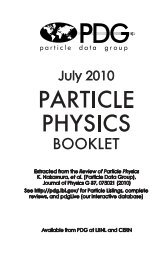30. Passage of particles through matter 1 - Particle Data Group
30. Passage of particles through matter 1 - Particle Data Group
30. Passage of particles through matter 1 - Particle Data Group
You also want an ePaper? Increase the reach of your titles
YUMPU automatically turns print PDFs into web optimized ePapers that Google loves.
E μc (GeV)<br />
4000<br />
2000<br />
1000<br />
700<br />
400<br />
200<br />
100<br />
<strong>30.</strong> <strong>Passage</strong> <strong>of</strong> <strong>particles</strong> <strong>through</strong> <strong>matter</strong> 33<br />
___________<br />
(Z + 1.47) 0.838<br />
5700 GeV<br />
Gases<br />
Solids<br />
___________<br />
(Z + 2.03) 0.879<br />
7980 GeV<br />
H He Li Be B CNO Ne Fe Sn<br />
1 2 5 10 20 50 100<br />
Z<br />
Figure <strong>30.</strong>24: Muon critical energy for the chemical elements, defined as<br />
the energy at which radiative and ionization energy loss rates are equal [5].<br />
The equality comes at a higher energy for gases than for solids or liquids<br />
with the same atomic number because <strong>of</strong> a smaller density effect reduction <strong>of</strong><br />
the ionization losses. The fits shown in the figure exclude hydrogen. Alkali<br />
metals fall 3–4% above the fitted function, while most other solids are within<br />
2% <strong>of</strong> the function. Among the gases the worst fit is for radon (2.7% high).<br />
agrees with the indicated mean calculated from the simulation. Electromagnetic<br />
and hadronic cascades in detector materials can obscure muon tracks in detector<br />
planes and reduce tracking efficiency [73].<br />
<strong>30.</strong>7. Cherenkov and transition radiation [74,75,34]<br />
A charged particle radiates if its velocity is greater than the local phase velocity<br />
<strong>of</strong> light (Cherenkov radiation) or if it crosses suddenly from one medium to<br />
another with different optical properties (transition radiation). Neither process is<br />
important for energy loss, but both are used in high-energy and cosmic-ray physics<br />
detectors.<br />
<strong>30.</strong>7.1. Optical Cherenkov radiation : The angle θc <strong>of</strong> Cherenkov radiation,<br />
relative to the particle’s direction, for a particle with velocity βc in a medium with<br />
index <strong>of</strong> refraction n is<br />
cosθc = (1/nβ)<br />
or tan θc = � β 2 n 2 − 1<br />
≈ � 2(1 − 1/nβ) for small θc,e.g. in gases. (<strong>30.</strong>41)<br />
The threshold velocity βt is 1/n, and γt = 1/(1 − β 2 t ) 1/2 . Therefore, βtγt =<br />
1/(2δ + δ 2 ) 1/2 , where δ = n − 1. Values <strong>of</strong> δ for various commonly used gases<br />
June 18, 2012 16:19







